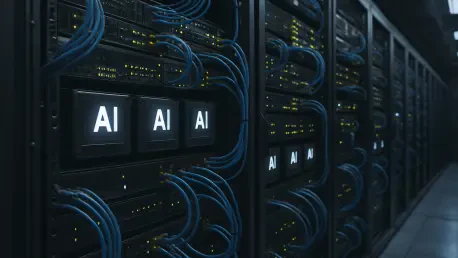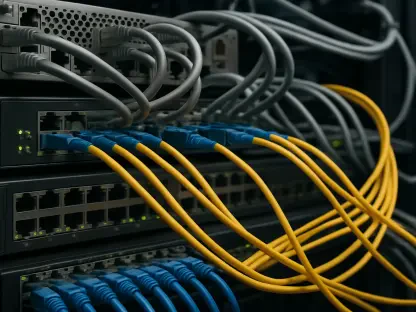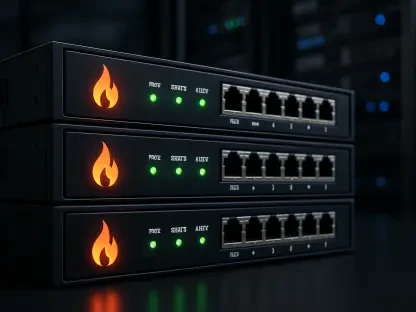In a landscape where artificial intelligence (AI) is reshaping the very foundation of global technology, the connectivity sector finds itself at a critical juncture, driven by an insatiable demand for cutting-edge infrastructure that can keep pace with rapid advancements. A potential $10 billion acquisition by Amphenol, a titan in high-performance connectivity solutions, of CommScope’s Connectivity and Cable Solutions (CCS) unit has emerged as a defining moment in this transformation. This deal is not merely a financial transaction but a bold strategic maneuver to seize dominance in a market propelled by AI’s relentless need for high-speed, low-latency fiber connectivity. As hyperscale data centers and 5G networks become the backbone of modern innovation, the stakes have never been higher. Companies are racing to secure assets that can support the explosive growth of AI applications, particularly in generative workloads that require immense data processing capabilities. This proposed acquisition signals a broader shift in the industry, where strategic positioning is paramount to long-term success.
Driving Forces Behind the Connectivity Surge
The connectivity sector is experiencing an unprecedented boom, largely fueled by the rapid adoption of AI technologies that demand robust infrastructure to function effectively. Hyperscale data centers, critical for handling massive AI workloads, rely heavily on fiber connectivity solutions that can deliver data at lightning speeds with minimal latency. This urgent need has positioned companies with advanced fiber technologies at the forefront of technological advancement. CommScope’s CCS unit, a key player in this arena, has demonstrated remarkable performance with a 20% year-over-year revenue increase and quarterly sales surpassing $724 million. Such figures underscore the unit’s pivotal role in supporting 5G networks and cloud computing ecosystems. As AI continues to evolve, the pressure on connectivity providers to innovate and scale intensifies, making strategic acquisitions like this one a logical step for industry leaders aiming to meet escalating demands and maintain a competitive edge in a rapidly shifting market.
Beyond the immediate technological drivers, broader industry trends reveal a landscape ripe for transformation as AI reshapes infrastructure priorities across multiple sectors. The surge in demand for high-capacity connectivity isn’t just a fleeting trend but a fundamental shift that’s redefining how companies operate and invest. Businesses are compelled to prioritize infrastructure that can handle the data deluge brought on by AI applications, from machine learning algorithms to real-time analytics. This environment has created fertile ground for high-value deals, as firms seek to acquire specialized units that can enhance their capabilities. For a company like Amphenol, targeting a powerhouse like the CCS unit isn’t just about expansion—it’s about securing a foothold in a future where AI-driven connectivity will dictate market leadership. The alignment of technological necessity and strategic opportunity sets the stage for blockbuster transactions that could redefine the competitive hierarchy within the connectivity space.
Industry Consolidation and Strategic Positioning
Industrial consolidation has become a hallmark of the connectivity sector as companies vie to strengthen their market positions through strategic acquisitions. Amphenol’s interest in acquiring CommScope’s CCS unit is a prime example of this trend, building on its earlier $2.1 billion purchase of CommScope’s wireless network units earlier this year. This potential deal represents a calculated effort to dominate the AI infrastructure race by integrating critical technologies and expanding access to a wide array of clients, including major internet service providers and data center operators. Such moves are not isolated but reflect a broader pattern across related industries like semiconductors and cloud computing, where firms are aggressively consolidating to build comprehensive portfolios. By pursuing this acquisition, Amphenol aims to not only grow its footprint but also gain a decisive advantage in a market where the ability to meet next-generation technology demands is a key differentiator.
The implications of such consolidation extend far beyond individual companies, signaling a reshaping of the competitive landscape in response to AI’s transformative impact. As larger entities absorb specialized businesses, the industry is witnessing the creation of powerhouses capable of addressing the complex needs of modern infrastructure. This trend is driven by the recognition that fragmented capabilities are insufficient in a world where seamless, high-performance connectivity is non-negotiable. For Amphenol, integrating the CCS unit would mean harnessing proprietary fiber technologies that are vital for staying ahead in a fiercely contested arena. Meanwhile, this wave of mergers and acquisitions highlights a critical reality: only those who can adapt through strategic alliances and asset accumulation will thrive in an era defined by rapid technological evolution. The focus on consolidation is a clear indicator of how seriously the industry views the challenges and opportunities presented by AI’s infrastructure demands.
Financial Motivations and Corporate Strategy
CommScope’s consideration of selling its CCS unit, which constitutes two-thirds of its total revenue, is rooted in a pressing need to address substantial financial challenges. With a long-term debt burden of $7.4 billion, the company is pursuing a deleveraging strategy to regain financial stability. A $10 billion sale of the CCS unit would provide a significant infusion of liquidity, enabling CommScope to reduce its debt load and redirect resources toward core competencies. This move is not about retreating but about strategically repositioning in a market where financial health is as critical as technological prowess. By divesting a high-value asset that is deemed non-strategic under its current business model, CommScope aims to streamline operations while capitalizing on the premium valuations driven by the AI infrastructure boom, ensuring it can navigate future challenges with greater agility.
This financial strategy reflects a broader trend among companies grappling with debt in high-growth sectors, where asset sales offer a pathway to balance sheet repair without sacrificing long-term potential. For CommScope, the decision to offload the CCS unit comes at a time when the market places immense value on AI-related infrastructure assets, justifying the hefty price tag. This transaction would not only alleviate immediate fiscal pressures but also allow the company to refine its focus on areas where it can maintain a competitive edge. The balancing act between shedding valuable units and preserving operational strength is delicate, yet necessary, in an environment where financial missteps can erode market confidence. CommScope’s approach underscores the importance of aligning corporate strategy with market realities, ensuring that divestitures serve as a catalyst for reinvention rather than a signal of distress in a rapidly evolving industry landscape.
Investment Potential and Market Dynamics
From an investment perspective, the potential acquisition of the CCS unit by Amphenol presents a compelling opportunity laden with growth prospects. The unit’s robust financial health, evidenced by EBITDA margins of 21.7%, suggests significant potential for margin expansion under Amphenol’s stewardship. This deal aligns perfectly with Amphenol’s ambition to target high-growth sectors, positioning it at the vanguard of the AI infrastructure surge. Historical data from previous acquisitions indicates that Amphenol has the expertise to integrate new assets effectively, driving operational synergies that enhance profitability. Investors are likely to view this transaction as a gateway to tapping into the burgeoning demand for connectivity solutions, where the ability to support AI-driven technologies translates into substantial returns over time, despite the initial high cost of entry into such a strategic market segment.
Additionally, the acquisition would diversify Amphenol’s revenue streams by incorporating the CCS unit’s extensive client network and proprietary fiber connectivity technologies, further solidifying its market standing. While the $10 billion valuation carries a steep multiple, the market’s enthusiasm for AI infrastructure solutions supports the premium, reflecting a consensus that strategic positioning in this domain is essential for sustained success. This deal would not only bolster Amphenol’s competitive edge but also signal to investors the immense value embedded in connectivity assets amid the AI revolution. The broader market dynamics suggest that such high-stakes investments are becoming the norm, as the race to build infrastructure for tomorrow’s technology intensifies. For stakeholders, the focus remains on balancing the risks of lofty valuations with the undeniable rewards of securing a leadership role in a sector poised for exponential growth in the coming years.
Shaping the Future of Connectivity
Reflecting on the potential $10 billion transaction between Amphenol and CommScope’s CCS unit, it becomes evident that this deal is a microcosm of the seismic shifts that have redefined the connectivity sector. It captures the essence of an industry adapting to the relentless demands of AI-driven infrastructure, where strategic acquisitions have emerged as a linchpin for survival and growth. For CommScope, the sale offers a lifeline to tackle crippling debt, while for Amphenol, it promises a leap toward market dominance through enhanced capabilities. Investors recognize the inherent potential, weighing the high valuation against the backdrop of unprecedented growth opportunities. Moving forward, the industry must focus on fostering innovation in fiber connectivity to keep pace with AI’s evolution, while companies should prioritize strategic partnerships and investments to build resilient portfolios. This moment in time underscores a critical truth: securing a competitive edge in connectivity will remain paramount for shaping the technological landscape of tomorrow.









